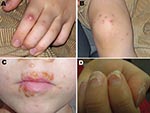
Vesicular eruptions in A) hand, B) foot, and C) mouth of a 6.5-year-old boy from Turku, Finland, with coxsackievirus (CV) A6 infection. Credit - CDC EID Journal
# 6533
In 1969, Surgeon General of the United States William H. Stewart, famously (and incorrectly) declared, "The war against diseases has been won."
Unfortunately, viruses, bacteria and fungi had other plans.
Which is why every few months we hear of a new emerging (or re-emerging) infectious disease somewhere in the world.
One of those recent arrivals - first detected in Finland in 2008 - is Coxsackievirus A6, which I initially wrote about in February of this year (see HFMD: An Old Illness With A New Cause).
HFMD is a very common viral infection, usually seen in young children during during late summer or early fall (although adults may be vulnerable as well).
It is caused by several of the non-polio enteroviruses. The two most common causes of HFMD have been the Coxsackie A16 virus, and the Enterovirus-71 (EV-71), and rarely, the Coxsackie A10 virus.
in the United States the disease is normally caused by the Coxsackie A16 virus and is generally mild.
Over the past decade we've seen outbreaks, particularly in the Far East, caused by the more pathogenic EV-71 virus. This version of HFMD can occasionally be quite serious (see EV71: Cambodia’s Prime Suspect).
After popping up around the globe (in Finland, Japan, Singapore & Taiwan) the past four years, late in 2011 coxsackievirus A6 was finally reported in the United States (in Alabama, California, Connecticut & Nevada (see MMWR: Coxsackievirus A6 Notes From The Field).
Unlike Coxsackievirus A16, CVA6 produces a more robust infection, and and can occasionally lead to serious illness. While no deaths were reported, the MMWR dispatch above indicated that nearly 20% of cases were hospitalized.
All of which serves as prelude to a letter recently published in the CDC’s EID Journal that describes a cluster of 8 patients who were treated last winter for CVA6 HFMD at Boston Children’s Hospital.
Volume 18, Number 10—October 2012
Letter
Hand, Foot, and Mouth Disease Caused by Coxsackievirus A6
Flett K, Youngster I, Huang J, McAdam A, Sandora TJ, Rennick M, et al.
(Excerpt)
In contrast to the typical manifestation, the patients in the Boston cluster exhibited symptoms in late winter (Table) and had perioral (Figure, panel A) and perirectal (Figure, panel B) papules and vesicles on the dorsal aspects of the hands and feet (Figure, panel C). Patients experienced a prodrome lasting 1–3 days, consisting of fever (8 patients), upper respiratory tract symptoms (4 patients), and irritability (7 patients).
This prodrome was followed by the development of a perioral papular rash (8 patients), which was often impetiginized with secondary crusting; a prominent papulovesicular rash on the dorsum of the hands and feet (6 patients); and a perirectal eruption (7 patients). Half of the patients had intraoral lesions. Fever abated in most of the patients within a day after onset of the exanthem.
The rash resolved over 7–14 days with no residual scarring. Samples from the oropharynx, rectum, and vesicles from these patients were sent to the Centers for Disease Control and Prevention (Atlanta, GA, USA) for analysis. Reverse transcription PCR and sequencing by using primers specific for a portion of the viral protein 1 coding region identified CVA6 (1) (Table).
(Continue . . . )
The authors caution:
Given the numerous CVA6 outbreaks in multiple countries in 2008 and a US population that may be relatively naïve to this serotype, CVA6 is likely to spread throughout North America.
Clinicians should be aware that, although standard precautions are routinely recommended for managing enteroviral infections in health care settings, contact precautions are indicated for children in diapers to control institutional outbreaks (10)
And indeed, just over two weeks ago we saw an alert out of the Washoe County Health Department (see Nevada: HFMD Coxsackievirus A6 Outbreak) over a fresh outbreak of CVA6 in their area.
While seemingly not as serious as the EV71 virus, CVA6 is a strong reminder of just how quickly emerging pathogens can appear, and that oceans are no longer effective barriers to their international spread.
For information, you may wish to visit the CDC’s extensive website on HFMD, where you’ll find audio podcasts by a CDC pediatrician on the illness, and links to other resources.
For more on HFMD, including the more severe Enterovirus-71 (EV-71) version found mostly in southeast Asia, you may wish to revisit the following blogs:
Vietnam’s HFMD Outbreak
China: A Recombinant EV-71
HFMD Rising In China
China Sounds Alert Over EV-71 Virus
Related Post:
Widget by [ Iptek-4u ]
